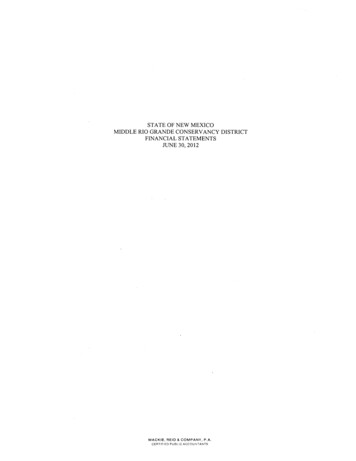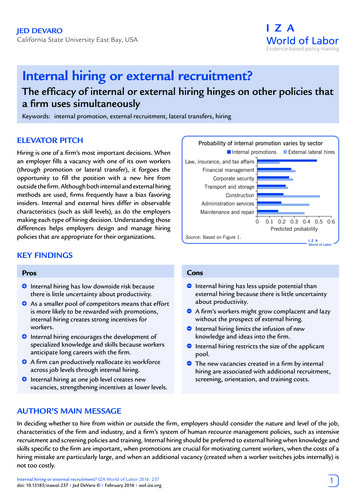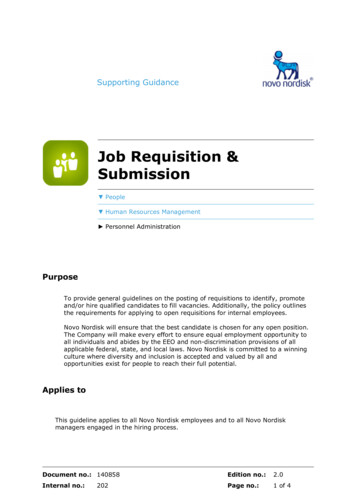
Transcription
Effective FacultyHiring PracticesDivision for Diversity,Equity and InclusionEFFECTIVE FACULTY HIRING PRACTICES1
With the publication of the UAMS Vision 2029 Report, UAMS renewedits commitment to diversity, equity and inclusion of UAMS leadership,faculty, staff and learners in order to enhance the education of ourlearners, reduce health disparities in our state, and honor the uniquecontributions provided by a diversity of values, beliefs, and cultures.2EFFECTIVE FACULTY HIRING PRACTICES
Why Is It Important?Diversity and excellence go hand in hand. Diversity of life experience,expertise, intellectual outlook, personality and cognitive style ofindividual faculty, staff and students enrich the collective intellectualenvironment in which learning and discovery occur. Often diversityis associated more narrowly with the race, ethnicity, gender, sexualorientation, age, religion, ability/disability, or other demographiccharacteristics. While it is true that diversity is much more than any ofthese specific categories, they are essential aspects of the excellencethat any academic institution should seek.These concepts underlie the development of this guide:A. Diversity: Individual differences (e.g., personality, abilities, andlife experiences) and group differences (e.g., race/ethnicity, age,culture, socioeconomic status, sexual orientation, gender identity/expression, language, and country of origin as well as political,religious, or other affiliation).B. Inclusion: A sense of belonging, feeling respected, valued for whoyou are; feeling a level of supportive energy and commitment fromothers so that you can do your best work. (Miller and Katz, 2002)C. Equity: Equality, impartiality, justice, and fairness as it appliesto opportunity, access, and resources, including institutional,professional and employment equity (e.g., salary, support staff,opportunities for hire and advancement).D. Cultural Competency: A set of congruent behaviors, attitudes,and policies that come together in a system, agency or amongprofessionals and enables them to work effectively in cross-culturalsituations, including cultural humility, awareness and sensitivity.(adapted from the National Center for Cultural Competencedefinition for cultural competency in the health professions, 1989)E. Underrepresented Minority: racial, ethnic and other populationsthat are underrepresented in a profession, at an institution ordepartment or division of a university, relative to their numbers inthe general population. (adapted from the Association of MedicalColleges definition for “Underrepresented in Medicine,” 2004)EFFECTIVE FACULTY HIRING PRACTICES3
This guide offers a set of recommended practices that may be adaptedto the unique needs of a college or department. It aims provideguidance to¾ Assist in diversifying the applicant pool.¾ Ensure that fairness and objectivity prevail in each step of theprocess.¾ Enable selection of the best candidate and increase diversity of theUAMS faculty.¾ Increase the likelihood that an offer is accepted.¾ Ensure that searches adhere to federal and state law and UAMSpolicy.¾ Assure that all candidates emerge from the process holding UAMSin higher regard.4EFFECTIVE FACULTY HIRING PRACTICES
The Faculty Search ProcessUnderstanding Factors that can Affect Success¾ To launch an equitable and effective search, the search committeeneeds to understand the factors that have affected outcomesin past searches that may affect the current search. Thus, thecommittee needs to review past searches by its department orcollege to answer the following:¾ Were all the qualified candidates interviewed?¾ Were applications received that were not considered because theyarrived later in the process?¾ Are there candidates from previous searches who should beconsidered and contacted regarding the current opening?¾ How many qualified women and underrepresented minoritypersons applied and how many were brought in for an interview?¾ If offers were made to either female or minority candidates andthey declined, is the reason for their decision known?¾ What can we learn from the past?The Search CommitteeA search committee should be comprised of individuals with differentperspectives and expertise, as well as a demonstrated commitmentto diversity. Generally, a dean or other appointing authority (e.g.,department chair) appoints a search committee. The chairpersonshould hold a senior position and be no less than a peer position tothe vacant position. The appointing authority may serve as committeechair or as a member of the committee.Recommendations for the search committee composition: Include potential peers and supervisors of the position and otherstakeholders within the department and college and across theuniversity.EFFECTIVE FACULTY HIRING PRACTICES5
Diversify. Racial, ethnic and gender diversity of the committee willenhance the search process. Including both senior and junior facultywill also provide diverse perspectives. A committee should includewomen and underrepresented minorities whenever possible. (Note:women and minorities are often asked to serve significantly more inthis capacity than majority males, so it is important to monitor theirservice load and/or, free them from less significant tasks.) Include a non-voting ex officio member (e.g., OHR representativeor a diversity advocate) who could serve as an advisor to thecommittee, monitor the search process, and provide guidance onlegal and equal opportunity-related issues.Search Committee OrientationIt is recommended that the chair, at the committee’s initial meeting,affirm the department’s commitment to conducting an equitablesearch and recruiting a diverse candidate pool. In addition, the initialmeeting is an opportunity to review: Recommendations of this guide on the steps of an effective search. Required time commitment and attendance expectations forcommittee members. Forms and tools to be used in the search process.Applicable policies, procedures and laws, available on the UAMS HRwebsite and updated regularly. UAMS HR Hiring Toolkits: hr.uams.edu/managers-toolkit/attract/ Faculty hiring resources: faculty.uams.edu/resources/6EFFECTIVE FACULTY HIRING PRACTICES
Minimizing Implicit Bias in the Hiring Process 11. Whenever possible evaluate job applications after maskingcandidates’ race, gender, or other group membership (Goldin &Rouse, 2000)2. Ask evaluators to commit to specific merit criteria and rank ordertheir importance before reviewing applications (Uhlmann & Cohen,2005).3. Reduce time pressure and distraction while making personneldecisions (Bertrand et al., 2005; Martell, 1991; Sczesny & Kuhnen,2004).4. Use structured interviews with standardized questions for hiringinstead of unstructured conversation (Bragger et al., 2002)5. Use gender-neutral job titles not masculine titles (e.g., chair notchairman). Masculine job titles activate masculine stereotypes(McConnell & Fazio, 1996)6. Finally, use same criteria in all recommendation letters. Emphasizeapplicant’s competence in research, teaching, service. Compareyour letters.From Mind bugs: How Implicit Bias Affects Faculty Evaluations inAcademia. Nilanjana Dasgupta, University of Massachusetts, Amherst1EFFECTIVE FACULTY HIRING PRACTICES7
The Recruitment PlanA strong recruitment plan delineates the essential steps of thesearch, identifies who is responsible for each (i.e., department chair,search committee chair or committee member, or other departmentpersonnel), and sets target dates for completion. It may also includedates for search committee meetings. The most efficient approach maybe for the chair to draft the plan for review and approval by the fullcommittee. A comprehensive plan would address and clarify processesfor:¾ Reaching agreement on selection criteria for the position andany weighting of them. Consider not only important criteria thatpertain to a candidate’s contribution to the intellectual diversityof the department, but also his or her ability to work with diversecolleagues, students, and other stakeholders.¾ Drafting of the position description and agreement by thecommittee.¾ Establishing each cut point in the selection process¾ Tracking the search and documenting outcomes. These records maybe critically important in the event of a lawsuit. The UAMS ExecutiveSearch Group can provide guidance on this aspect of the search.¾ Screening applications and CVs to determine which candidates meetminimum and preferred qualifications.¾ Contacting references for selected applicants.¾ Selecting candidates for an initial interview.¾ Initial interviews (may be on the phone, by video-conferencing or inperson). This includes the question to be used in the interview.¾ Candidate evaluation after the initial interview.¾ Selection for short list and campus visits.¾ Campus visit.¾ Comparative evaluation of candidates on the short list.¾ Final recommendation.¾ Conclusion of the search and debriefing.8EFFECTIVE FACULTY HIRING PRACTICES
Effective Recruitment PracticesFinding qualified candidates includes reaching out to colleaguesthrough established, familiar networks. In addition, the followingapproaches help broaden the pool. Some require time to nurture,but in the long run can be fruitful. Allowing 30 days for responses isrecommended. Advertising in scientific journals. Networking via listservs Advertising in journals, otherpublications and on websitesaimed at female and minorityscientists. Announcements on jobs listsincluding UAMS’. Networking at professionalmeetings. Always utilizemeetings as an opportunityto identify and connect withpotential candidates, even whenno vacancy exists Announcements to professional Inviting promising candidatesto campus to present on theirorganizations and listservs.work as a way to cultivate Contacting colleagues at otherrelationships for future searchesinstitutions who may know of Soliciting help from minorityqualified candidatescolleagues (at UAMS and Contacting, and sending theelsewhere) with cultivatingjob announcement, to faculty atrelationships at minority-servingother institutions who might beinstitutions that may led to thepotential candidatesidentification of candidates Announcements to departments Asking fellow faculty andat institutions that graduate orgraduate students to helpemploy (as faculty, fellows oridentify candidatespost-docs) high percentages of Not ruling out “hiring our own”minorities and women– i.e., new doctoral graduates, Announcements throughpost-docs and those completingfunding and advocacy agencies,residencies and fellowshipsparticularly those that seek toadvance and support minorities Social mediaand women in the fieldEFFECTIVE FACULTY HIRING PRACTICES9
Monitoring the Demographicsof the Applicant PoolFaculty hiring committees are required to use the UAMS HR talentacquisition system and / or the UAMS JFR hiring system (College ofMedicine only). The HR talent acquisition system automatically tracksapplicants demographics as required by Title VII and Executive Order11246. For more information on applicant tracking processes andrequirements, contact the Office of Human Resources.After the application deadline closes, the ex-officio diversity advocateof the search committee should review the demographics of applicantsto determine if underrepresented groups are sufficiently represented.This determination is based on national U.S. Census demographicsdata for various professions. If not, the ex-officio diversity advocatemay recommend that the committee considers revising its recruitmentapproach; for example, if targeted marketing was not used, it maydecide to extend the closing date to try that approach.Standardized processes for evaluating candidates and documentingeach evaluation will help reduce bias, identify all who are qualified,and protect UAMS in the event of litigation. This applies to the initialscreening of all applicants, initial interviews, short list candidateinterviews and the final selection.Screening Applications for Initial InterviewsIn this initial round, it is important for the Search Committee to keep inmind:¾ Prioritization of criteria often yields varying perspectives. Tryranking candidates by different criteria (e.g., research potential,teaching experience, mentoring capacity) to generate candidatelists.¾ The effect of evaluation bias on the rating of women and minoritycandidates. Double-check their qualifications and how they havebeen rated for signs of bias.10EFFECTIVE FACULTY HIRING PRACTICES
¾ Be aware of biases that could inadvertently or unfairly excludequalified applicants¾ With non-traditional career paths.¾ With non-traditional research interests, publications, or workor life experience.¾ From historically black colleges and universities or otherminority-serving institutions.¾ With a disability¾ With veteran status.Consider having the search committee and the HR representativefor your area independently screen the applications for minimumqualifications.Best Practices for Interviewingand Evaluating CandidatesPreparation for the interview¾ To ensure consistent treatment of all candidates, including internalcandidates, schedule interviews so that as many of the searchcommittee members can participate.¾ A standardized set of interview questions should be developedbefore the interview and distributed to all search committeemembers. See Developing Interview Questions, below.¾ Use the same questions in all interviews to ensure fair comparisonof all candidates.¾ All search committee members should have had ample time beforethe interview to review the candidate’s CV. Offer the members anopportunity, preferably at the beginning of the meeting or call, toask questions about the candidate’s CV.EFFECTIVE FACULTY HIRING PRACTICES11
¾ Prior to the interview, send the candidate the following, allowingample time for review:¾ A description of the department’s programs and faculty needs.¾ Policies and procedures for evaluation, promotion, and tenure.Developing interview questions¾ Focus on the candidate’s scholarship and skills, rather than hisor her demographic characteristics. It is generally not helpful tomake a point with candidates that the department is eager to hirewomen and minorities.¾ Be sure to include questions that will elicit information about thecandidate’s qualifications as they relate to crucial aspects of theposition.¾ Include questions that will elicit information about the candidate’spromise and potential for contributing to the long-term objectivesof the department.¾ Ask the candidate about his/her qualifications for teaching,scholarship and service.¾ Ask about work in diversity (e.g., efforts to recruit, retain, orpromote women and minorities; involvement in diversity-relatedprograms, committees or initiatives).¾ If the candidate is applying for a leadership role (division chief,department chair, etc.), ask about the candidate’s commitmentto goals of diversity and equity, as well as the candidate’shistory of mentoring women and underrepresented minorityfaculty.¾ Include questions designed to evaluate “emotional IQ”/abilityto work with others.¾ Only include questions that are appropriate and lawful. Thisis essential to UAMS’ compliance with its equal opportunityobligations. Have all search committee members review theguide about inappropriate or unlawful questions.12EFFECTIVE FACULTY HIRING PRACTICES
Initial InterviewsTo save travel time for candidates and expense for UAMS, searchcommittees are increasingly using phone or video interviews as thefirst step in the interview process. In many cases, a 30-minute phoneinterview can enable the committee, and the candidate, to determinewhether the candidate and the position are likely to be a good matchand whether the recruitment process should proceed to an on-campusinterview. The phone or video interview should be taken as seriously asany face-to-face interview. It is important that as many members of thesearch committee as possible are on the call.Three messages to communicate during any interview, whether onvideo, telephone, or on-campus, are as follows:¾ UAMS is seriously interested in the candidate’s scholarlycredentials and work.¾ UAMS is a good place to develop an academic career and thrive ina lively academic atmosphere.¾ UAMS has a variety of supportive, family-friendly policies in placeand cultivates a diverse educational environment.How these messages are communicated can make a critical differencein whether the top candidate joins the UAMS faculty or not.Creating the Short ListAt this stage in the process, the objective is to identify up to threehighly qualified candidates to be invited for a campus visit. To ensurethat the most qualified candidates are selected, it is recommended thatthe committee review the selection process up to this point, including:¾ Evaluation of each candidate against all selection criteria.¾ The way criteria are prioritized. Different approaches can yieldvarying perspectives. Try ranking candidates by different criteria(e.g., research potential, teaching experience, mentoring capacity)to generate candidate lists.¾ The effect of evaluation bias on the rating women and minoritycandidates. Double-check their qualifications and how they haveEFFECTIVE FACULTY HIRING PRACTICES13
been rated for signs of bias.¾ Awareness of biases that could inadvertently or unfairly excludequalified applicants¾ With non-traditional career paths.¾ Non-traditional research interests, publications, or work or lifeexperience.¾ From historically black colleges and universities or otherminority-serving institutions.¾ With a disability.¾ With veteran status.In-Person VisitHere are recommended practices to consider:¾ Focus on the candidate’s ability to perform the essential functionsof the job. Try to avoid making assumptions based on perceivedrace, ethnic background, religion, marital or familial status, age,disability, sexual orientation, gender expression, or veteran status.¾ Give the candidate a chance to interact with the department’sfaculty (and key staff) in multiple venues. Formal talks maynot reveal every candidate’s strengths. Consider including Q Asessions, “chalk talks,” and other less formal interactions.¾ Introduce women and minority faculty and staff to all candidates,not just women and minority candidates.¾ Create opportunities for all candidates to meet with faculty, staffor community members who potentially represent opportunitiesfor interdisciplinary or community collaboration.¾ Ensure that all questions asked are appropriate and lawful. Thisis essential to UAMS’ compliance with its equal opportunityobligations.14EFFECTIVE FACULTY HIRING PRACTICES
After the interviewTo reduce risk of unconscious bias influencing judgments asrecollections of the candidate fade:¾ As soon as possible, each member of the Search Committee whoparticipated in a candidate interview should independently ratethe candidate using the same evaluation template.¾ The search committee should meet as soon as possible after aninterview to evaluate the candidate.¾ Describe the position for which the candidate is being considered,so that the reference can give a more accurate evaluation of thecandidate’s suitability.¾ Let the reference talk freely for as long as he/she wishes withoutinterruption. An interruption may mean you might miss gettingimportant information.¾ Ask follow-up questions, when you feel the contact is reluctantto discuss certain factors. It may help to explain why you arepersisting on a line of questioning.¾ Do not end the call until you are sure you know the opinion of theperson you have called. If the reference was ambiguous or reticent,try summarizing what he/she has said by saying “I take it that youdon’t recommend the candidate very highly for this position” or “Itsounds like you highly recommend the candidate for this position.”This may encourage the reference to clarify his/her opinion.¾ Conclude the call by thanking the reference.¾ Check more than one reference. Doing so will help ensure that youare not getting a one-dimensional perspective on the candidate.¾ It is important to remember that all questions asked duringreference checks must be job-related. It is illegal to ask questionsof references that cannot be legally asked of the applicant.EFFECTIVE FACULTY HIRING PRACTICES15
Final SelectionEvaluation of a candidate should occur as soon as possible after allmeetings and interviews are over. Search committee members andothers solicited for input should complete the candidate evaluationform. The search committee should then meet to discuss the resultsand formulate recommendations.Making the OfferThe way in which contract negotiations are conducted can have ahuge impact not only on the immediate hiring outcome, but also ona new hire’s future success at UAMS. The actual negotiation is oftenbetween the candidate and the dean or chair and may not involve thesearch committee. However, to ensure equity, the search committeeand dean should consider providing all candidates with a completelist of topics for discussion in the course of negotiations. Women andunderrepresented minority faculty candidates may have received lessmentoring about hiring negotiations during their careers than theirmajority counterparts, and may therefore be at a disadvantage inknowing what they can legitimately request in negotiations. Thesemight include¾ Salary¾ Discretionary funds – books,¾ Course release time / teachingjournals, memberships, etc.load¾ Travel fund¾ Release time for research¾ Secure parking¾ Service expectations¾ Summer salary¾ Tenure clock stoppage¾ Moving expenses¾ Lab equipment / space /¾ Assistance with partner /renovationspouse career options¾ Research assistants / teaching ¾ Child / elder careassistants¾ Tuition exchange or remission¾ Clerical / administrativefor dependentssupportBe sure to provide clear, detailed information about mentoringpractices as well as all review criteria and milestones such as annualreviews, third-year reviews, tenure reviews, and post-tenure promotionreviews.16EFFECTIVE FACULTY HIRING PRACTICES
Concluding the SearchThe search concludes with the following by the search committee chair,committee members and/or department personnel:¾ Debriefing and thanking the search committee¾ Notifying unsuccessful interviewees¾ Announcing the new hire to the department, and in some cases,the campus¾ Gathering / retaining documentation¾ Evaluating the search¾ Evaluation of the search should be throughout the search andafter it concludes. If at any point, it becomes apparent that theapplicant pool is not diverse enough, or sufficiently well-qualified,reassess the advertising and recruitment process. Analyze whetherthe hiring net was cast broadly enough and, if not, what can bedone. Sometimes the pipeline constrains the outcome, but often acommittee can do more to attract outstanding candidates.¾ If the department hires a woman and/or underrepresentedminority candidate, consider the factors that may have enabledit to do so and keep a record of good practices and successfulsearches for future reference. If the applicant pool was not aslarge, qualified, or diverse as was anticipated, consider:¾ Could the job description have been constructed in a way thatwould have brought in a broader pool of candidates?¾ Could the department have recruited more actively?¾ Were there criteria for this position that were consistently not metby women or candidates of color?¾ If a woman and/or underrepresented minority candidate wasoffered a position that they chose not to accept, what reasonsdid they give? Are there things that the department could doto make it more attractive to such candidates in the future? Besure that any analysis and insight is shared with departmentaldecision-makers and OHR is part of the process for initiating futuresearches.EFFECTIVE FACULTY HIRING PRACTICES17
For more information or assistance:Contact UAMS Office of Human Resources, at (501) 686-5650 orAskHR@uams.eduAcknowledgements:Faculty recruitment guides of Drexel University, Pennsylvania StateUniversity, Massachusetts Institute of Technology, the Universityof Wisconsin, and the University of Michigan contributed to thedevelopment of this guide.This guide was initially started by the UAMS Chancellor’s MinorityRecruitment and Retention Committee (CMRRC) in 2016 and updatedby the UAMS Division for Diversity, Equity, and Inclusion (DDEI) URMfaculty committee in 2020.18EFFECTIVE FACULTY HIRING PRACTICES
ddei.uams.eduEFFECTIVE FACULTY HIRING PRACTICES19
Division for Diversity,Equity and Inclusion20EFFECTIVE FACULTY HIRING PRACTICES
Faculty hiring committees are required to use the UAMS HR talent acquisition system and / or the UAMS JFR hiring system (College of Medicine only). The HR talent acquisition system automatically tracks applicants demographics as required by Title VII and Executive Order 11246. For more information on applicant tracking processes and










